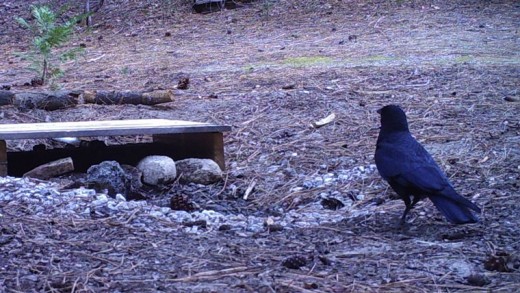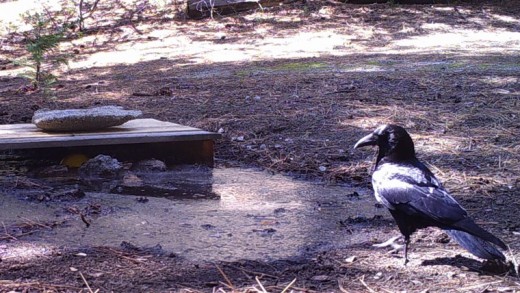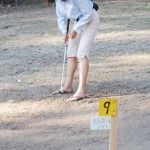
Photos courtesy John Laundré

Photos courtesy John Laundré
For those of you who remember the “Journal from the James” article on bobcats, I had mentioned I would follow with more periodic articles on the wildlife that have been showing up on the cameras we have placed around Idyllwild and Pine Cove. In this month’s installment, I have decided to write about two closely related species, crows and ravens.
Both belong to the family Corvidae. This is a large bird family that not only includes these two species but Steller’s and scrub jays that are also commonly seen in the area, but more on them later. The members of this family are normally considered to be quite intelligent and can be found throughout the world.
In North America, of the two species, the crow is the most widely distributed. It is found in all 48 lower states and well into Canada. The raven is restricted more to the Western states but does extend extensively to the south in Mexico and across most of northern Canada and into Alaska.
Over their respective ranges, ravens and crows are some of the more commonly seen and heard bird species. However, they are often far from the most loved species.
For a variety of historic mythical reasons, Europeans have never had very favorable views of ravens and crows, often seen as being dark, sinister and evil. One only has to read Poe’s classic poem to know those feelings transferred equally to America.
Crows and ravens are on America’s “varmint” list, a whole group of native animals most people can’t see a reason to have around and so they might as well be shot on sight. Even where crows are protected, for example in Minnesota, one can still shoot one anytime if it is doing or about to do damage. I guess one looks for the evil glint in its eye.
This negative attitude we have against crows and ravens is unfortunate as they play important roles in the weave of nature we call an ecosystem. The biggest role they play is as scavengers. Though we can look at disgust at animals who eat dead things, they indeed maintain the health of ecosystems by their sanitary habits.
Crows and ravens also play the role of predators, preying on a variety of small animals. As such, they, like the other predators as I mentioned in a previous article, are the guardians of ecosystem integrity, keeping these small herbivore species from becoming overabundant.
Lastly, they, too, are prey of other species. Though we would find it hard to “eat crow,” owls have no hesitation in doing so. Owls will hunt crows who have roosted for the night. In turn, during the day, if crows find a roosted owl, they will “mob” it to drive it away. Such are the intrigues of predator-prey relationships.
It is this multiplicity of roles that crows and ravens play — of scavenger, of predator and of prey — that make them truly jacks of all trades in the natural world.
This approach has ensured their survival over eons of time and epic changes of climate. They are far from the sinister demons we portray them as and we should admire them instead for their intelligence, ingenuity and contribution they make to our forest ecosystem.
This, you might say, is all fine and good, but how do you tell them apart? Though they are both totally black in color, there are four characteristics that distinguish crows from ravens.
The first, and hardest, is their size. Ravens are bigger and stockier than crows, weighing about 2.5 times more. They also have a larger wingspan. But unless you see them side by side, which happens rarely, size alone is hard to go by.
The second distinguishing characteristic is the size and shape of their beaks. Again, ravens have a much larger, broader, heavier beak compared to the more stiletto-shaped beak of the crow.
The third way to tell them apart is by their call. Crows have the classic “caw” and it sounds as it is written. Ravens, however, have a more guttural and variable call that sounds like a crow with a sore throat.
For me, however, the easiest and most surefire way of telling if you are looking at a crow or a raven is in the tail. This is especially true if you see them flying. The raven’s tail feathers end in a very definite rounded shape. In contrast, the tail feathers of a crow end in a more flat triangle.
So whether you see a crow or a raven, and now can tell them apart, you are seeing some of the more intelligent and, to me, interesting species of our bird community here on the Hill.
Although not as melodious as most, the call of both is still music to my ears. And, it’s unfortunate that many people still think poorly of them.
Although our attitudes toward crows and ravens are a lot better than they have been, there are many who would want to return to the glory days of indiscriminant killing of these magnificent birds. To them, I can only say — nevermore.










